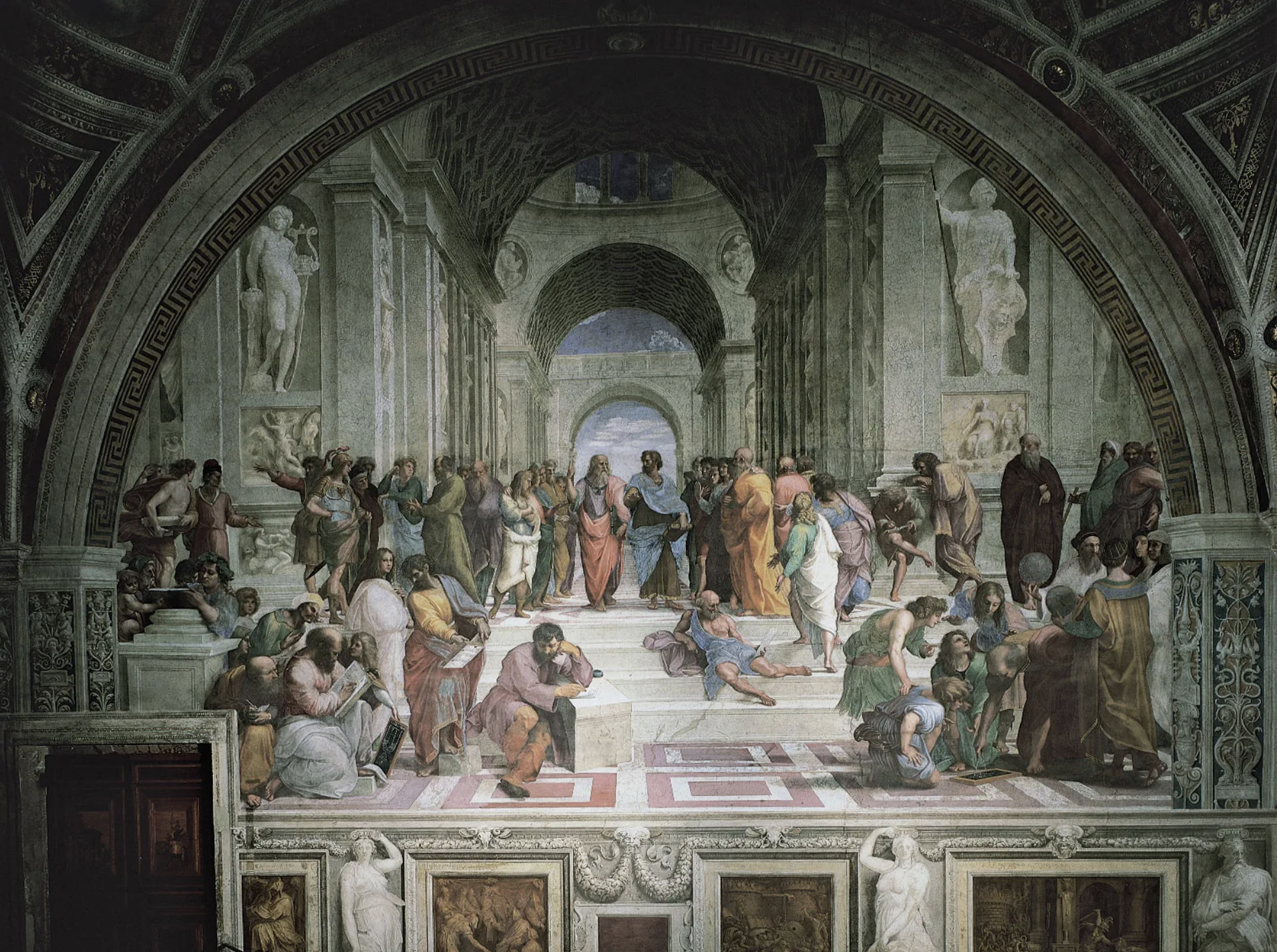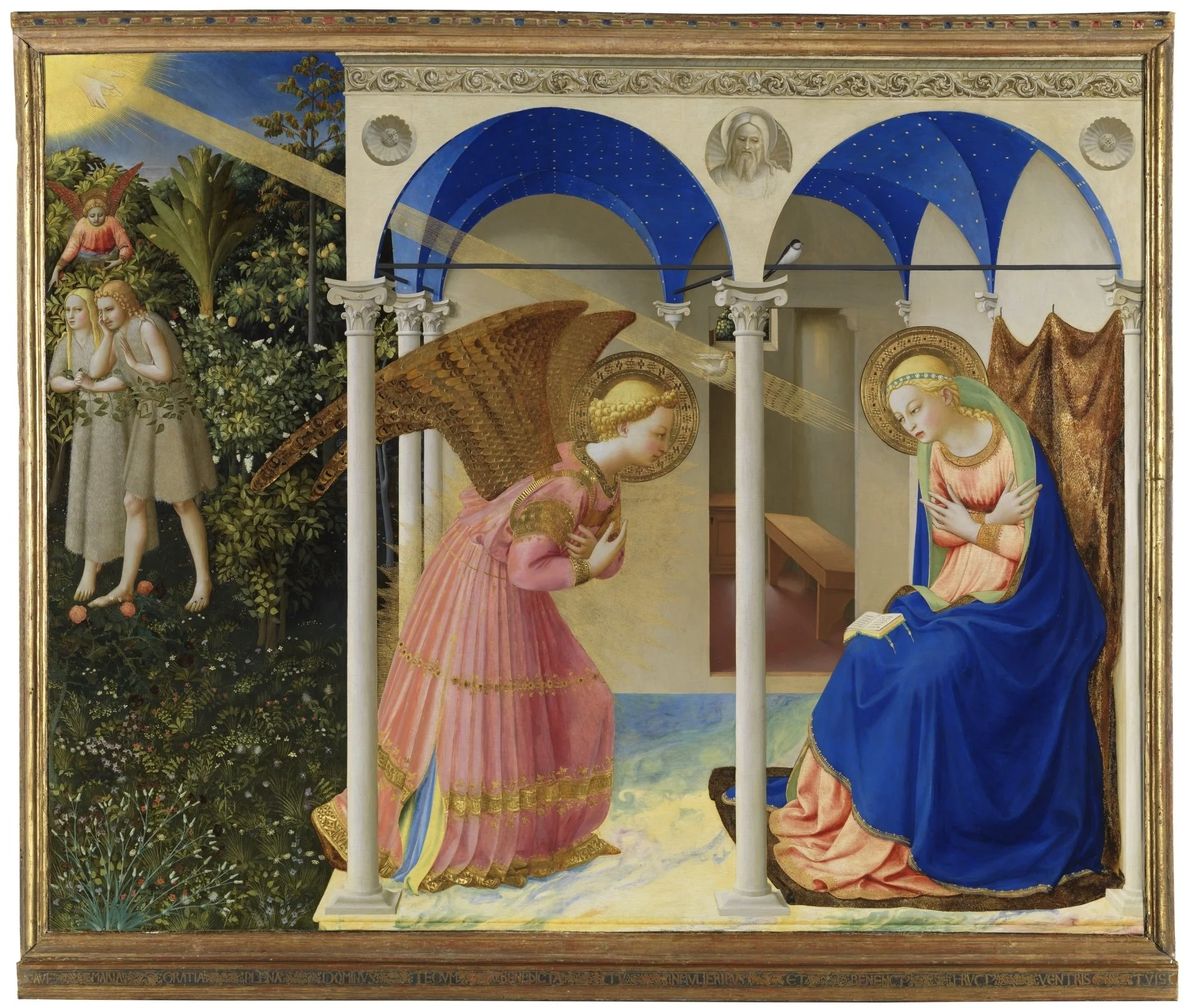Symmetry and Sentimentality: Wes Anderson and the Afterlife of Classical Composition
By Hanna Yoon
Film Still from Wes Anderson, The Royal Tenenbaums, 2001.
Image courtesy of IMDb.
Walking through the pastel interiors of Wes Anderson’s cinematic universe, I found myself asking a question that felt both art historical and oddly confessional: what happens when the rigorous geometry of classical painting – its symmetry, its architectural authority, its belief that beauty is a form of moral order – reappears not in a chapel of palazzo, but in a pink hotel, a Khaki Scout camp, or the townhouse of a dysfunctional New York home? If Raphael balanced the divine with immaculate precision, Anderson balances bellboys, runaway children, and wounded geniuses with the same devotional clarity. His frames do not merely resemble paintings; they behave like them. They are secular altarpieces dedicated to the fragile hope that harmony might still be possible.
Raphael, The School of Athens, 1509-11, Fresco, 500 cm × 770 cm.
Image courtesy of Britannica.
This connection is most apparent in the symmetrical corridors of The Grand Budapest Hotel (2014). Anderson’s Zubrowka is less a fictional nation than a memory place – an Alpine diorama arranged with the composure of High Renaissance architecture. Like Raphael’s School of Athens, where every figure orbits a vanishing point with mathematical precision, Anderson’s compositions guide the eye with priestly authority. The hotel’s lobbies, bathed in confectionery light, echo the perspectival chambers of the Renaissance studiolo – intimate rooms where knowledge and order were believed to be mutually sustaining. But Anderson complicates this legacy: where Raphael used geometry to exalt reason, Anderson uses it to dramatise its fragility. A perfectly centred concierge desk becomes a symbol of civility in a continent slipping toward war. Harmony becomes a kind of emergency lighting – beautiful but flickering.
Nicolas Poussin, The Rape of the Sabine Women, c. 1770, Oil on paper on canvas, 56.5 x 108.9 cm.
Image courtesy of the National Gallery of Art.
Anderson’s classical sensibility often invokes the seventeenth-century rigour of Nicolas Poussin, whose bodies are arranged with the deliberate choreography of theatre. Anderson echoes this discipline not through figural composition but through the orderly arrangement of space itself. In The Grand Budapest Hotel, the movements of hotel staff – the neat diagonals of pastries, keys, and telegrams – recall Poussin’s belief that narrative clarity emerges from spatial order. Even the chaos of a prison break feels Poussinian: bodies arranged with geometric inevitability, every gesture serving the overall harmony. Anderson’s precision, like Poussin’s, is a moral proposition: that beauty is a form of ethics, a way of resisting collapse.
But Anderson’s The Royal Tenenbaums (2001) arguably emerges as his most personal, most emotionally charged work; a film that transforms a brownstone townhouse into a dynastic portrait gallery – half museum, half mausoleum. The Tenenbaum home, its walls filled with portraits, relics, and trophies, resembles the cluttered splendour of a Baroque studiolo. Each child – Richie, Margot, Chas – is introduced as a panel from a family triptych, their talents framed as if they were minor deities in a secular pantheon. Their rooms function as curated chambers of identity, arranged with the meticulousness of an aristocratic archive. Anderson’s symmetry here is not only visual; it is psychological, a way of containing the emotional entropy that threatens to spill across every painted surface.
Richie Tenenbaum’s world, soft and melancholic, carries the still-life quietude of a Chardin painting. His tent – glowing, centred, devotional – is a small sanctuary of classical balance within the family’s emotional ruin. Meanwhile, Margot Tenenbaum, framed in doorways and bathed in the diffused melancholy of sepia lighting, evoked chiaroscuro portraits of the eighteenth century, in which the sitter’s pose concealed their inner storms. Each Tenenbaum becomes a study in classical restraint, undone by Romantic longing – order straining beneath the surface.
Film Still from Wes Anderson, Moonrise Kingdom, 2012.
Image courtesy of Mubi.
In Moonrise Kingdom (2012), the influence of neoclassical pastoral painting becomes even more explicit. Suzy Bishop, standing atop a lighthouse with binoculars in hand, could be a Romantic heroine in a Friedrich landscape – poised at the edge of the world, longing inscribed by horizon. Anderson’s landscapes, though stylised, carry the metaphysical weight of the picturesque. They are not just settings; they are emotional climates that diagram the balance between order and desire.
Fra Angelico, The Annunciation, 1425-1426, Tempera on poplar panel, 190.3 cm x 191.5 cm.
Image courtesy of the Museo Del Prado.
Anderson’s interior – the compositions of patterned wallpaper, symmetrical furniture, and reverent lighting – recall the devotional stillness of early Renaissance frescoes. Like Fra Angelico, he uses architecture as a vessel of spiritual quiet. But Anderson is too modern, too sceptical, to let serenity remain intact. His frames often contain small ruptures: a cigarette, a secret, a wound. Stillness becomes a performance and not a guarantee.
This is where Anderson’s cinema becomes more than whimsical design. He is staging an art historical argument, one that spans from the Renaissance through Neoclassicism to Postmodernism: Can beauty still hold when the world is falling apart? Can composition still console? Anderson answers with a kind of uneasy optimism – his symmetry is a refuge, not a solution.
Leaving an Anderson film, I thought of art theorist Leon Battista Alberti’s insistence that the picture frame is a “window onto the world” – a promise that representation can bring coherence. Anderson inherits this Renaissance faith but filters it through contemporary melancholy, shared by much of today’s art and culture. His frames do not reveal order so much as they reveal the longing for it.
In an era defined by disarray, Anderson’s devotion to classical balance becomes quietly radical. He reminds us that composition – not just what we see, but how we arrange it – remains one of art history’s most powerful emotional techniques. His cinema is proof that symmetry, like nostalgia, is never purely decorative. It is a way of believing. A way of holding the world steady, if only for the length of a shot. Proving that the art of arrangement remains beautifully, heartbreakingly alive.
Bibliography
Angelico, Fra. 2015. “The Annunciation.” Museodelprado.es. Museo del Prado. 2015. https://www.museodelprado.es/en/the-collection/art-work/the-annunciation/9b02b6c9-3618-4a92-a6b7-26f9076fcb67.
Heckmann, Chris. 2022. “VIDEO: Wes Anderson’s Symmetrical Editing.” StudioBinder. April 24, 2022. https://www.studiobinder.com/blog/wes-anderson-symmetry/.
“Moonrise Kingdom (2012) | MUBI.” 2024. MUBI. 2024. https://mubi.com/en/gb/films/moonrise-kingdom.
Pulimood, Steven. 2019. “School of Athens.” In Encyclopædia Britannica. https://www.britannica.com/topic/School-of-Athens.
“The Rape of the Sabine Women by French 18th Century.” 2025. National Gallery of Art. 2025. https://www.nga.gov/artworks/1218-rape-sabine-women.
“The Royal Tenenbaums (2001) - Photos - IMDb.” 2025. IMDb. 2025. https://www.imdb.com/title/tt0265666/mediaindex/?ref_=mv_close.





